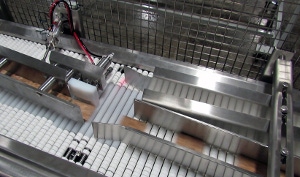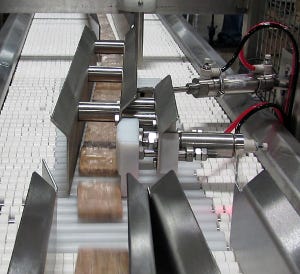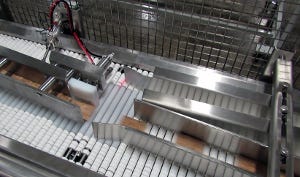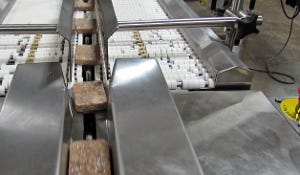
An upgraded dual bar-wrapping line at Datrex has more than doubled output of its life-saving maritime food bars. Datrex is one of the world's leading manufacturers and distributors of safety and survival equipment and supplies used in the commercial marine industry. Its main product line is survival equipment for use in escape vessels aboard cruise ships, cargo ships, commercial fishing boats and off
1rrrr - Datrex automated diverter - 3.jpg
shore oil platforms.
As regulated by the U.S. Coast Guard and other international marine governing bodies, such escape vessels must contain specific quantities of food and water rations to sustain life in the event of an emergency or disaster. Critical among these survival necessities are food bars, which, over the past 20 years, have grown to be a continually expanding product line for Datrex; not only in the marine industry, but for inclusion in emergency preparedness kits used during earthquakes, flooding and hurricanes where food supplies can be interrupted.
This growth stretched the company's food-bar packaging line beyond its capacity. In mid-2011, Datrex opted to expand and upgrade the line to increase its throughput volume. "The packaging line that we had in place worked well for many years," says Scott Mills, evp operations at Datrex. "But we got to a point where we had so many orders coming in that the line just could not handle the production requirements anymore."
Survival food bars
Dating back to the early 1990s, the Datrex food bar line was primarily a manual process. The line manufactures and packages two sizes of survival food bars-2,400 calorie and 3,600 calorie respectively-both made with all-natural ingredients and supporting a five-year shelf life. Each food bar provides enough calories and nutrition to sustain one person for three days.
The production process required the product to be compacted to approximately 3 in. x 4 in. x 3 in. cubes using a tablet depress. This reduces the size of the bars so they take up less room on lifeboats and life rafts where space is limited. In 2008, Datrex upgraded the speed and performance of its tableting machine to a multi-station rotary press to improve throughput.
Once manufactured, the bars are individually wrapped in a shrink wrapper, run through a heat tunnel and then manually placed into vacuum-sealed pouches that are boxed, palletized and put into storage or sent straight to shipping.
Throughput on this line was governed by the speed of the existing wrapper. But escalating sales volumes demanded higher throughput. The company needed to expand the capability of the downstream packaging line to handle these production levels. To engineer a solution, Datrex reviewed design proposals from a number of packaging manufacturers, and finally selected Conflex Inc. to design a shrink wrap solution and Shuttleworth to engineer an automated conveyor and wrapper infeed solution.
"Using Conflex and Shuttleworth as a joint design team proved a successful approach," says Mills. "They were able to propose a custom design, bringing into play the respective strengths from each company, in shrink wrapping and automated conveying, to achieve a universally integrated packaging line."
Dual shrink wrappers
A unique aspect of the new line is its integrated dual parallel wrappers. Instead of designing a line where one wrapper is running at exceptionally high speeds, which opens the door for jam-ups and mis-wraps as well as accelerated equipment wear, the Conflex/Shuttleworth design team integrated the existing wrapper and a second higher-throughput wrapper into two separate but integrated shrink lines.
Key to this successful integration is the Shuttleworth accumulation 
2 rrrr- Datrex automated diverter - 2.jpg
conveyor. After the food bars exit the tableting stations, they are conveyed single-file through a section of specialized Shuttleworth accumulation conveyor with low back pressure, called Slip-Torque, before being diverted into two separate lanes feeding the two wrappers.
An automated diverter feeds a preset number of bars into the slower, original wrapper lane; then feeds a larger quantity of bars into the lane to the faster wrapper. This cycle is repeated continuously. In this way, each wrapper is fed a proper proportion of food bars relative to its production capability.
Optimized accumulation
The operation of the accumulation conveyor into the diverter poses a critical aspect in the handling of the food bars to eliminate product jam-ups, shingling and damage to the bars. Shuttleworth's Slip-Torque technology, which provides low line pressure throughout the continuous-motion accumulation conveyor, makes this possible.
This low back pressure allows precise product placement and virtually eliminates product damage. Should the line need to slow or stop, the conveyor can continue to accept food bars from the upstream conveyor for a specified period of time instead of stopping the line. A low-pressure accumulation buffer absorbs irregularities in the production flow and provides a smooth, even flow on the line.
Slip-Torque uses individually powered rotating roller shafts and loose-fit rollers, which become the conveyor surface. They are powered by a continuous chain. The size and weight of the food bars determines the driving force. When the product stops on the surface of the conveyor, the segmented rollers beneath the product also stop, but the chain continues to run.
Conveyors with Slip-Torque have the ability to modulate the speed of different sections of the conveyor via a central control PLC and HMI. As food bars move down the line, the rollers at the back end of the conveyor can be moving faster than the ones at the front end of it. Additionally, the products can be moving at variable speeds on different sections of the conveyor as dictated by throughput requirements.
Continuous-motion wrappers
Both shrink wrappers are Conflex CW 160 continuous-motion horizontal form/fill/seal wrappers. However, the new wrapper has a higher-speed film delivery system and dual high-speed flying rotary hot knives to cut off the leading and trailing edges of each package simultaneously. The newer wrapper, which can operat
3rrrr - Datrex - Servo-Smartfeed - 2.jpg
e at speeds of 170 bars/min, was built as a mirror image to the first so that one operator could run both wrappers.
A major upgrade on the new wrapper was the bar infeed system. On the original wrapper line, once the food bars are diverted to the conveyor for infeed to the wrapper, a servo-gate brings the bars to a physical stop and then drops the gate. Stopping the bar limits the indexing speed into the wrapper and is part of the reason for the lower production speeds on that machine.
Infeed into the new wrapper, on the other hand, is automated with Shuttleworth's Servo-SmartFeed technology. It measures the leading and trailing edges of the continuous line of bars, and simultaneously calculates the location of the physical flights or lugs running through the wrapper. It then accelerates or decelerates each bar into the appropriate lug space.
Servo-SmartFeed is designed to dynamically accumulate and synchronize the release of food bars into the wrapper without stopping the product flow. It links the wrapper infeed to upstream product flow and maintains the packages in motion while the downstream equipment is operational.
The system operates in four speed-registration zones to manage the infeed of food bars:
1. The first zone accepts the product from the upstream conveyor at the diverter, then moves it downstream toward the wrapper;
2. The second zone closes the gaps between the bars so that they are positioned back-to-back;
3. The third zone increases the spacing between the bars equal to the pitch flight on the wrapper;
4. The fourth zone positions each individual bar into the gaps between the flights.
The wrapper and SmartFeed continuously communicate with each other and react to whatever food bars are moving through the line. When there is a delay with an item, SmartFeed tells the wrapper that no item is in position and to slow down or stop. When the next item is in position, SmartFeed tells the wrapper to start, providing there is accurate indexing of the product to be wrapped. Servo-SmartFeed creates an integrated system monitoring the flow of product through to the wrapper. Controls installed upstream regulate the speed of the line throughout, directed by SmartFeed.
Film is delivered to the wrapper from an overhead roll and the two edges are heat sealed together beneath the food bars to form a continuous tube encasing the bars. The tube continues beneath the dual seal rotating wheel described previously, which seals and separates the individual packages.
The food bars exit both wrappers on separate conveyors using Slip-Torque technology, are combined onto a common conveyor, move through a common shrink tunnel and are manually packed into pouches that are vacuum packed, cartoned and palletized.
The Conflex CW 160 uses controls and an operator's HMI from Beckhoff Automation (see "‘Open' PC control keeps component sourcing flexible" on p.27) for additional information.
Model efficiency
Completed in March 2012, the new packaging line is a model of throughput efficiency, with the capability of processing a high volume of food bars with a minimal defect rate.
"With the installation of the new packaging system we have increased our production capacity by more than 125 percent compared to what we were previously running," says Mills. "Running these high volumes with such a miniscule defect rate is exactly what we were looking for in a packaging system."
Beckhoff Automation, 952-890-0000, www.beckhoffautomation.com
Conflex Inc., 262-512-2665, www.conflex.com
Shuttleworth LLC, powered by Pro Mach, 260-356-8500, www.shuttleworth.com
‘Open' PC control keeps component sourcing flexible
Established in 1988, Conflex Inc. is a leading designer and manufacturer of shrink wrapping solutions in the U.S. Its CW Series of high-speed horizontal form/fill/seal wrappers is among the most sophisticated in the packaging industry. Conflex maintains a philosophy that equipment should be simple in design, fast to changeover and easy to maintain. In 2006, it made the decision to switch the operating systems for its machines to TwinCAT software from Beckhoff Automation.
"We use a Beckhoff CX1020 embedded PC instead of a typical PLC and corresponding I/O cards," says Conflex president Bill Morrissey. "Combined with the open TwinCAT software, this allows our customers to use HMI's, servo drives and motors and other components from almost any company they want on our machines. The end user will not be locked down to utilizing our brand if a component goes down. They can buy a comparable component from any company source.
"For example, our HMI control is handled within the embedded PC, so we can use a basic touchscreen monitor rather than a touchscreen with a processor that also holds the HMI portion of the program. If our monitor is broken for any reason, our customer could actually plug in a laptop and run the machine with the laptop until the new monitor arrived. They will never be hard down. Same thing if a servo drive fails. The open architecture of the PC control system enables our machines to use multiple brands of motion controllers and servo motors."
Morrissey cites these other advantages of the Beckhoff technology:
•Faster processor speeds are possible due to the synchronization of the motion and HMI within
the single embedded PC.
•The initial system costs less versus comparable PLC-based systems.
•Conflex can add training videos and PDFs (manuals and machinery drawings) for viewing on the machine monitor by the operators.
•The user can easily connect their machine to their intranet and use the equipment's on-board reporting functions to extract information such as production statistics with Microsoft Excel.
•Conflex can connect to a customer via an Ethernet/internet connection to provide offsite/remote support from any PC anywhere.
•A backup of a machine's program file can be done on either an SD card or simply put on the company's server. Reloading the machinery program is as simple as inserting the SD card or importing it from their server via their intranet.
•Future hardware updates can use the same software program thus significantly reducing the engineering time on new developments.
About the Author(s)
You May Also Like


